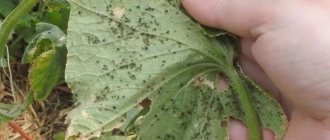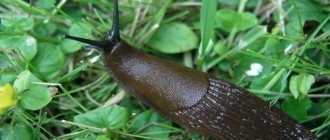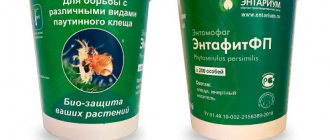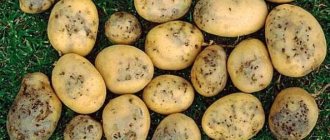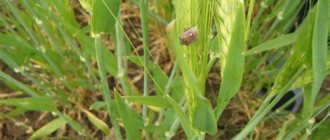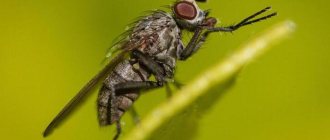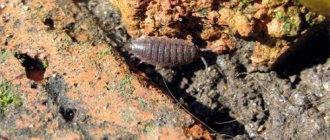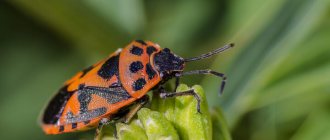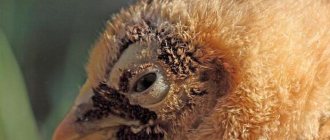What does a wireworm look like?
The body of the wireworm is elastic, dense and elongated, part of the integument on the abdomen is chitinized plates. The yellow or light brown body consists of a head and 9 segments: 3 thoracic and 6 abdominal.
The head is a quadrangle, narrowed in front, with rounded corners. There are 5 pairs of main setae on the frontal plate; different species may have additional setae. On the membranous base there are antennae consisting of 3 segments.
The pest has double jaws, the upper one is sickle-shaped with small teeth and 3 pairs of legs. All are equally developed and covered with hairs, bristles and small spines.
Adults have a flat body 7–20 mm long. The color of beetles can be dark brown, gray, brown, black with a metallic tint. Insects have a natural ability to make loud clicking sounds, turning over on their backs and jumping. For this feature they are called click beetles . Unlike larvae, adult insects feed little and do not cause significant damage to plants.
In our country, different types of beetles are common: dark, striped, shiny, steppe, Siberian, broad, sowing.
What kind of pest is this
The wireworm got its name due to the rigidity of the integument and its external resemblance to a piece of wire. This is not an insect, but the larva of a click beetle. By itself, it is not capable of causing harm to root crops, but its offspring cause great damage.
The larva lives approximately 3–4 years. Therefore, if an area is affected by these pests, there are individuals of different ages in the soil. In the first year of life, the larvae are not capable of causing significant damage to the crop due to their low activity. They spend the cold period of the year at a depth of up to 30 cm. By the beginning of the warm season, they increase in size, the chitinous shell becomes even denser and acquires a bright yellow color.
What does a wireworm look like?
There are several types of click beetles. The most malicious pests are dark, striped and steppe. The color of the larvae of these insects varies from light yellow to dark brown. Their sexual characteristics are undeveloped.
Depending on the type of beetle, the color and proportions of the body of female and male larvae may differ
Wireworms belong to the class of oligopodials. These larvae have a long worm-like body covered with a chitinous shell. Consist of a head, 3 thoracic and 9 abdominal segments. There are three-membered antennae on the head. The upper jaws are powerful and sickle-shaped. The lower ones are a dense plate. The greatest intensity of growth is observed in the first two years of life.
The larva reaches a length of 50 mm. These are adult individuals with a hard and durable shell, which is almost impossible to crush. The wireworm is voracious and is most active in the evening.
What harm does the larva cause to plants?
The wireworm gnaws round, long and winding passages in the pulp of tubers. Such a root crop soon rots, and the death of its above-ground part, the bush, is also possible.
The wireworm destroys not only root crops, it is polyphagous and eats seeds, roots, and the near-ground part of the stems
Based on the nature of the damage, two groups of wireworms are distinguished:
- Preferring cereal crops, eating seeds and plant roots. This group includes all larvae of beetles of the genus Agriotes. Hence their second name – “cereal nutcrackers”. They can also damage vegetable crops, but less intensely than representatives of the second group.
- They prefer underground parts of plants: root crops, roots, seed material. These are beetles of the genera Seletosomus, Melanotus, etc. Their larvae are able to penetrate into the cavity of the stems and rise above the ground level. Such pests are most dangerous for corn, tobacco, vegetables and melons.
Signs of damage to the roots and tubers of plants, including potatoes, by the pest
Having discovered the presence of a pest, you need to decide how to get rid of the wireworm most quickly and effectively
The fact that there is a wireworm in the area can be determined by several signs:
- Low germination of bulbous plants.
- Young seedlings die soon after they emerge or are planted.
- Holes appear in the roots and tubers, and the through passages of the worms are clearly visible in the section. These cavities are populated by fungi and bacteria, which subsequently leads to decay.
Wireworm larvae and adults
The development of the click beetle lasts 4–5 years . In the spring after wintering, female beetles lay small white eggs at the root collar of plants. Each clutch can contain 3–10 pieces. In 1 year, the female lays up to 200 eggs .
After 3–4 weeks, larvae 1.5–2.2 mm long emerge from them. The body of wireworms is initially light and transparent, and the head is yellow.
The insect spends 2–5 years in the wireworm larvae During the first year, the larvae grow up to 5 mm. For the winter they burrow 0.5 meters into the ground. The next year they continue to grow and develop.
Under unfavorable conditions, the larvae lag behind in development. The exact number of molts and generations of the wireworm cannot be determined. It depends on the type of pest, humidity, temperature, and availability of food. Most often, molting occurs 7–14 times, in the first year – 1 time and in subsequent years in spring and autumn. At the same time, larvae of different ages, ranging from 15 to 30 mm in length, can simultaneously be present in the soil at a depth of 10–12 cm.
In the first year, the larvae are inactive; as soon as they hatch, they feed on humus. The next year they change color to yellow or light brown and actively search for food. From this period, the wireworm becomes a dangerous pest.
The final transition from the perennial larval state to the adult stage occurs in June-August. Having finished feeding, the larvae pupate in the soil at a depth of 5–15 cm. After 2-3 weeks, young click beetles appear, which immediately go to winter and fly out of the ground, only next spring - in April-May, to begin a new breeding cycle.
How to detect wireworms on the site
Wireworm larvae, which are brightly colored, are clearly visible on dark soil when plowing or digging up an area. As a rule, they live at a depth of 15-30 cm, and in dry soils they go down to a meter. Therefore, they cannot always be found in the upper layers of the soil.
If a superficial inspection reveals nothing suspicious, the presence of pests will only become apparent during harvest. When small holes are noticeable on the tubers, as if punctured by wire, or thin dark passages are visible when cutting or peeling potatoes, this is a sure sign that wireworms have settled in the soil.
Unreasonable wilting and stunted growth of the above-ground parts of some potato bushes can also serve as an alarming signal.
Signs of plant infection
The voracious larvae of the click beetle damage seeds, roots, tubers and root crops of plants .
eat the embryo of the seeds , leaving a thin shell and deep holes on the sprouts. The pest gnaws holes in tubers and root crops and makes complex moves. This promotes the penetration of pathogens and decay.
In seedlings, the wireworm damages the tender roots and gnaws through the main stem . Plants wither and die.
The wireworm causes the greatest harm in spring and summer; at the beginning of autumn, the pest leaves for the winter.
How to identify a wireworm
I wrote that the garden pest prefers to live in the ground, feeding on root crops, which makes it difficult to meet it “face to face.” You can tell if there are wireworms in your area by the following characteristic signs:
- In tubers and root vegetables there are black dots, spots, narrow winding passages.
- Only individual bushes are damaged, and not the whole ridge or plantation. Wireworms can dig a vertical passage up to 1-2 m. But it is difficult to move in the horizontal direction - a maximum of 20-30 cm. Therefore, they prefer to feed on 1-2 neighboring plants.
- During the period of pest activity, it is possible to detect when digging up a garden in the upper layers of the soil.
Another sign is the appearance of adult click beetles. Outwardly, they are almost indistinguishable from useful ground beetles. However, the pest, turning over from its back to its abdomen, makes a clicking sound.
What soils does wireworm like?
The number of pests is affected by soil moisture and salt concentration in it. Most species living in the central regions do not tolerate moisture deficiency well. Only steppe species are more resistant to fluctuations in soil moisture. During drought they go deep into the earth.
Click beetle larvae love acidic soils overgrown with weeds. In such places there is always a lot of food for them. Of the weeds, the most favorite are wheatgrass, quinoa, and thistle.
In saline areas, pests feel worse, since particles of ammonium, potassium and sodium damage their chitinous covers.
Thanks to its ability to migrate deep into the ground, the wireworm hides from harmful high temperatures and frosts. Although in the central regions the pest can survive for several days when the temperature drops to -6 to -10°C.
The wireworm prepares for wintering in advance. Within 2 months, the volume of water in the body decreases and the amount of glycogen increases.
What plants does wireworm damage?
The wireworm is not a species of insect, but a click beetle larva. The beetles themselves do not cause much harm - they feed on the leaves of cereals. But their females lay up to 100 eggs over the summer, from which a serious enemy of potato plantations emerges - the wireworm.
The larva is a long-liver among insects: if there is food, it can live in the ground for up to 5 years, eating crops. It is difficult to physically destroy a wireworm - it lives underground, breaking through winding passages through which it quickly escapes from the threat.
click beetle and larva (wireworm) enemy of the gardener
2-4 year old individuals are considered dangerous. These wireworms are easily recognized by their clearly segmented body (which makes them look like a worm) with many legs. The length of the larva is 2-3 cm. The color varies from yellow-chestnut to dark brown.
Adult worms have a very thick chitinous shell. It is almost impossible to crush an insect - if you catch a pest, it is easier to tear it apart, cut it into two parts. Although potatoes are considered its favorite food, the wireworm does not disdain almost anything:
- Corn, tomatoes, beets, carrots, onions, cabbage.
- A plant at any stage of development: from seed to fruiting stage, dying.
- Any parts of plantings: root system, fruits, stems, leaves.
The cunning of the pest is that it tolerates wintering well in frozen ground. If you do not control the wireworm this year, the larva will continue to destroy plantings in future seasons.
What crops does the pest affect?
Wireworms damage the seeds and underground parts of many vegetable and ornamental plants.
Potato tubers, dahlias, gladioli, beet roots, carrots, strawberry roots, corn, daffodil bulbs, tulips, and iris rhizomes are subject to their invasion . Wireworms can chew through tomato .
Wireworm in potatoes
Wireworm in potatoes
Potatoes are the wireworm's favorite vegetable. Together with the Colorado potato beetle, these are the main crop pests. Once settled in a potato plot, wireworms can damage up to 60% of the tubers. Juicy potato roots are also a source of food for beetle larvae. Because of this, nutrition in the bushes is disrupted and the tuber yield is reduced.
Fungi, bacteria and nematodes settle through holes in the pulp. Damaged tissue around the passages turns black, and the tubers become inedible.
Wireworm damage
The main harm is damage to potato tubers. The wireworm, gnawing into the pulp, spoils the presentation of the tuber and leaves the surface riddled with holes. Many passages appear inside.
Potatoes affected by the larvae of the thrower lose their presentation, and their shelf life deteriorates significantly. Such tubers are not stored; they rot in 1-2 months.
How to get rid of wireworm?
Chemical and biological drugs
Bazudin
Contact insecticide based on diazinon. Destroys the pest by penetrating the intestines. The anti-wireworm drug is applied to the soil once when planting tubers. The depth of application of the product is 5–15 cm.
It is recommended to mix the drug with dry sand or sawdust before application. They fill a 1 liter container ¾ full and add 30 g of insecticide. Add 1 teaspoon of the working mixture to each well. The protection period lasts 15 days.
Zemlin
Granular preparation with odor. Used as bait for pests. It enters the insect's body along with food and poisons it from the inside.
When planting potatoes, bulbs and tubers of other plants, the drug is used in the same way as Bazudin. The product is mixed with sand or sawdust and applied to the soil when planting. 30 g of the drug is enough to treat 20–30 m².
Initiative
The insecticide is applied to the soil before sowing seeds, planting seedlings and planting material of vegetable and ornamental crops. 2 tsp. a mixture of dry sand and 30 g of the drug is added to each well. The product begins to act on the first day after application.
Prestige
A modern systemic contact drug based on imidacloprid. Once in the pest's body, it paralyzes and causes death. 20–25 ml of the product are diluted in 1 liter of water and sprayed on the planting material before planting.
Provotox
Granular preparation for soil application. The consumption rate of the drug is 40 g per 10 m². The insecticide is applied to the prepared soil after harvesting or during planting. Place 1–2 granules in each hole at a distance of at least 5 cm from the tubers or seeds. The product should not be used at temperatures above 25°C. The best time to use is in the morning from 9 to 10 o'clock or in the evening after 18 o'clock.
Metarizin
Bioinsecticide for the prevention and destruction of wireworms and other pests. Contains fungal spores from the genus Metarizium. After applying the drug to the soil, wireworms ingest fungal spores. They germinate in the intestines of the pest and spread throughout the body. Spores can germinate immediately in the soil and penetrate the body of insects through the chitinous cover.
The fungus releases substances that are toxic to the pest and the beetle larvae die. Spores emerge from decomposed remains and infect other pests. The protective effect lasts for several years.
Dissolve 0.5 liters of bioinsecticide in a bucket of water and water the soil with the solution when digging or hilling. The drug has a short shelf life; it must be used within 3 months after production.
Anthonem-F
An effective biological product based on nematodes. Together with irrigation water, nematodes enter the soil and then into the pest’s body. The product acts as an intestinal insecticide.
Inside the wireworm, nematodes multiply and after 8–15 days, thousands of new nematode larvae emerge from its body, capable of infection.
Only wet soil is treated with the biological product in the morning, evening or afternoon in cloudy weather. The air temperature should be between 10–28°C. Anthonem-F is capable of reducing the number of click beetle larvae by 95–100%.
Traditional methods
- When digging in spring, lime (120–150 g per 1 m²) or 20–25 g are added to the holes when planting. In acidic areas, this method solves two problems: it improves soil pH and fights wireworms.
- ash saves you from wireworms . 2–3 tbsp. l is added to each hole when planting potatoes and other vegetables.
- Before planting, tubers and bulbs are soaked in a decoction of onion peels . 1 kg pour 5 liters of water and bring to a boil. Use after cooling.
- Instead of onion broth, seedlings and tubers can be treated with a 1% solution of potassium permanganate .
- Mustard powder effectively fights wireworms . 1 teaspoon of powder is poured into the hole. In heavily infected areas, add a little hot red pepper .
- In small areas in the spring before planting, the use of bait . Pieces of potatoes, carrots, and beets are placed in moist soil at a depth of 5–10 cm. After 2–3 days, the baits are checked; if pests are present, the baits are doused with boiling water and the insects are destroyed.
How to fight the click beetle using folk methods
Wireworms have always annoyed farmers and gardeners, and if collective farms used insecticides on an industrial scale, then at the dacha it is appropriate to try folk remedies for wireworms .
Secrets of fighting click beetle larvae:
- The wireworm may not be given the opportunity to reproduce in the spring. Before sowing, the soil is moved manually with a shovel or cultivator to a depth of 10 cm.
- Before planting, a “trench” up to 15 cm deep is dug in several places along the length of the field. Stringed slices of raw potatoes strung on a rope are lowered into the ground and sprinkled. After 3-5 days they open it - beetle larvae stick to the slices and can be destroyed.
- During the flight of beetles, chopped raw potatoes are placed at the bottom of a 3-liter jar. Bury it up to the neck in a damp, shady place. The “trap” is checked periodically and the beetles are destroyed.
- The larvae love to settle in the roots of cereal plants and corn. These crops can be planted between rows, along the edges of paths. As soon as the root system grows (flowering-earing period), the cereals are dug up; if there are larvae between the roots, everything is burned. Under no circumstances should green material be stored in compost.
Nettle infusion is made at the rate of 500 g of green mass per 10 liters of water. Every 2-3 days for 7-10 days, the prepared holes are spilled with infusion; a bucket of water is enough for 20 holes. You can also use infusions of mother and stepmother (200 g), dandelion (100 g).
Instead of or in addition to infusions, it is recommended to plant marigolds and marigolds around potato plants and beds. They are very fragrant and repel pests. The flowers are not weeded out, the wilted ones are left until winter, and in the spring, having been seeded, they will grow again.
To combat wireworms use:
- Onion peel. It can be placed in each hole along with potatoes or soaked tubers. The wireworm does not like the smell, and phytoncides kill fungal diseases.
- Mustard powder. It is added 1 tsp. into the hole, can be mixed with red pepper powder. The mixture repels pests and heals the soil.
- The wireworm does not like the smell of young, fresh pine needles. After planting, the beds are covered with spruce branches.
Baits and traps for the pest should be made throughout the entire period, from spring to autumn.
Biological method
It is based on attracting natural enemies of the click beetle - birds - to the garden. Insectivores: tits, flycatchers, starlings, etc. must definitely settle near the house. To do this, birdhouses are hung, feeders are placed, and trees are planted.
Prevention
- Autumn digging of the soil reduces the number of pests. The layer of earth is turned over and not broken into clods. In heavily infected areas, it is better to carry out this procedure later, on the eve of frost. Some larvae and adult beetles end up near the surface of the earth and die from low temperatures . In spring and early summer, when eggs are being laid, deep loosening . Detected beetles and their larvae are immediately removed from the ground and destroyed.
- Areas overgrown with weeds, especially wheatgrass and thistle, . The pest loves to feed on the roots of these herbs.
- The wireworm avoids places where legumes used to grow. This fact is taken into account when planning crop rotation. Beans and peas can be planted in rows around the perimeter of the site. Planting calendula and marigolds . The secretions of these plants discourage the wireworm's appetite.
- It is important to monitor the acidity of the soil. At elevated pH levels, lime the soil or add ash (2 liters per 1 m²). This worsens the living conditions of insects.
By carrying out prevention and systematic treatment of the soil with preparations, you can get rid of wireworms on the site in a few years.
More details: you will learn how to deal with wireworms from the video.
How to destroy a pest
To get rid of wireworms, an integrated approach is required:
- The main rule in the fight against this pest is to deep dig the area in the fall. This must be done before the first frost. This method kills up to 90% of larvae;
- It is recommended to sow mustard or alfalfa on the dug up soil. They will scare away the insect;
- Digging up the soil in the spring will destroy the larvae and beetles themselves, and also reduce the growth of weeds. They provide a haven for these insects.
- Do not plant the same crops in the same place;
- Do not leave root vegetables in the soil over the winter. The larvae must be deprived of food;
- If plantain, horsetail and sorrel are actively growing on the site, then they may indicate increased acidity of the earth. It is a good environment for wireworms to live. In such cases, slaked lime or cement dust is used to deoxidize the soil;
- Birds help well in this fight. Starlings especially love to feast on these larvae. Install birdhouses and attract birds, but be careful, they can also peck out the planted seeds;
- Gardeners recommend planting legumes between rows of potatoes. Wireworms do not favor these plants.
Folk remedies for pest control have been invented over the years. They are time-tested. Unlike chemicals, they are non-toxic and will not harm your health. When digging, add dried orange peels or onion peels to the soil. It's even better to put them in each hole. Wireworms will be repelled by these products, but they will not be destroyed. However, in such places the harvest will be preserved.
The larvae die from ash, so it is recommended to sprinkle it between the rows and each hole. The remedy for larvae is nitrogen fertilizers. An infusion of celandine is indispensable in this fight. Grind 500 g of the plant into a bucket of water and leave for 40 minutes. Then water the plants at the roots with it.
Another good way to get rid of wireworms is to set wireworm traps. The wireworm will not leave them unattended.
Take a 0.5 liter jar and put pieces of potatoes in it. Cut off the top of the bottle and insert the hole down into the bait jar, secure with tape or something else. Bury the jar in the garden so that the entrance remains open and larvae and beetles can crawl into the funnel from the bottle. The design will not allow them to crawl back out. After a couple of days, dig it out and destroy the pests.
Popular: Methods for treating indoor roses from pests
Two weeks before planting potatoes, sow corn or oats in the place chosen for them, after moistening them in an insecticidal agent. Then dig them up with the larvae. Bury several potato halves treated with poisons near the main beds. Pests will crawl to them, and after a couple of days they will need to be dug up and, preferably, burned.
How wireworms reproduce in the garden
The so-called click beetle reaches its immediate maturity within five years of life. Females that have survived after a hard winter lay their eggs on the surface of the ground in the first stages of autumn. The color of these eggs is white, and the size barely reaches half a millimeter.
But in this case everything will depend on the climate where the beetle is present. Therefore, the process of laying eggs can continue from May to early June. The most favorable places for females are certain cracks in the soil, various depressions in the ground, accumulation of weeds, and so on.
It is important to know that one female of this beetle is capable of laying about 250 eggs at a time. The evolution of eggs to larvae also varies depending on the climate of a particular region. The period lasts from 20 to 40 days. When concrete individuals emerge from the larvae, they settle in the soil and the first year of their life poses absolutely no harm to plants.
The most favorable indicators for the qualitative development of these living substances are a temperature of about 20 degrees with a humidity of about 50 percent. Further, young wireworms grow every year and acquire the appearance that is already characteristic of adult beetles. It all depends on the specific type of beetle; the color can be yellow, brown, and so on.
Beginning in its second year, wireworms begin to become an immediate problem for various plants in your garden bed. After four years of life, the beetle becomes an adult.
How to remove a parasite
When producing means to combat this beetle, information was taken about the conditions for its direct reproduction. It is necessary to understand that the main priority for the beetle is plants of a bulbous nature. Therefore, in the place where these plants grow, it is necessary to create the most unfavorable conditions for the insect.
If your soil is acidic, it may be advisable to add lime to it. This addition should be carried out in the fall with additional digging of the site. You will need lime in an amount of about 200-300 grams per square meter. If you plan to reduce the level of this acidity in another way, you can use egg shells or wood ash.
An effective way to get rid of wireworms is to eliminate weeds where the beetles like to lay their eggs. In this case, it is necessary to eliminate first of all the weeds called wheatgrass and thistle, since they are the favorite plants of the wireworm. It would also be very advisable to plant several crops on the site, which themselves repel the larvae. This includes soybeans, beans and legumes.
Such parasites are repelled by the smell of marigolds. It is advisable to plant such plants near your bulbous crop.
The land on the site should not be planted too often. If this is not possible due to the small size of the plot, then you need to weed the area more often.
Popular: Reasons why monstera leaves turn yellow and what to do
When autumn comes, the entire area should be properly dug up. If larvae somehow get into the soil, you can take them out and they will destroy themselves.
Wireworm danger
The wireworm larva can reach 45 mm. It can be yellowish or dark brown in color. The insect damages plants, roots, stems and seeds of vegetable crops. Vegetables damaged by insects should not be eaten.
The insect can live up to 5 years. At the beginning of its life, the wireworm larva is in the soil and feeds on the root part of plants. But after two years the insect becomes a serious pest of all plants. A surface eaten away by insects is susceptible to the spread of fungus and rapid rotting during storage.
The larvae are especially active when weather conditions are favorable to them. Dry, hot summers encourage wireworms to penetrate deep into root crops to search for moisture. In moist soil, root crops show less damage.
How to get rid of it in the fall
Various countermeasures will help you get rid of the annoying wireworm. The main ones include proper planting of vegetable crops. At the same time, it is necessary to properly apply mineral fertilizers, which will significantly reduce the number of insects. In emergency cases, there is a need to use chemicals. Folk means of struggle cannot be ruled out.
You can fight wireworms using various methods. Let's talk about a few in more detail:
Correct use of agricultural technology will help get rid of insects. On autumn days, the soil should be dug up. Detected insect larvae are destroyed. All weeds and old growth are removed from the garden. It is important to follow crop rotation technology, which involves planting vegetable crops annually. You can sow green manure plants. They help saturate and loosen the soil. When seedlings appear, green manure is dug up.
Mineral products can eliminate wireworms in a short time. The most common product used in the garden is saltpeter. The effect of the composition causes changes in the level of acidity of the soil, which leads to the death of the wireworm. Ash and chalk will help change the acidity of the soil. These funds must be applied in the autumn before digging up the garden.
Potassium permanganate or lime have good disinfectant properties. As an alternative, you can use potassium chloride, but only in October - November, so that until spring this substance is washed away by rain and snow with components dangerous to root crops and humans.
To successfully combat harmful insects, a number of chemical products are used. Toxic chemical compounds should only be used in accordance with safety regulations. Effective chemicals that destroy wireworms include “Bazudin”, which is a granular powder. The product enters the stick insect’s digestive system and paralyzes it, followed by death. All these tips will give results, but it is better to deal with this problem together with your neighbors. After all, this year the wireworms that did not die can move to a neighboring site, and next year they will return to you again.
Currently reading:
- Folk and chemical remedies for fighting slugs in the garden
- We create hanging gardens in an apartment with indoor vines
- How to grow Chinese cabbage in open ground
- Seven types of pears for planting, caring for and growing fruits
Share the news on social networks
About the author: Vladimir Petrovich Efremov
Chief agronomist of the limited liability company “Association of Peasant (Farm) Farms “Kuznetsovskaya””, Ilovlinsky district of the Volgograd region.
Ways and methods of pest control
Remember! The wireworm loves abandoned lands covered with wheatgrass, only there it is able to reproduce and feed well.
The first remedy after which the number of beetles on your site will noticeably decrease is soil cultivation. The fewer various unkempt and abandoned places in your garden, the less scope it will have.
Agrotechnical measures to combat the click beetle
The earth needs to be deoxidized, and in the spring you should lime your soil. The soil should be checked for acid content using special tests sold at any gardening center. But, remember that immediately after liming or planting green manure, click beetles will not leave the area, but only their number will decrease.
So, what radical agrotechnical measures need to be taken:
- Neutralize the soil if it is acidic by liming or using ash. Bring it into the holes, when digging, pour the ash solution onto the ground, sprinkle the ground with ash on the floor of the plant. Click beetles really don’t like these substances, so they leave.
- Sow green manure on the plot: radish, buckwheat, mustard, rapeseed, sweet clover, legumes, and others. The wireworm is killed by these plants. Plant them twice a season, they will have time to do their beneficial work. It is advisable to plant plants for several years for prevention.
- Plant crops on your site in different places that repel the wireworm and its “parents”. These are helper plants: marigolds, phacelia. They also perfectly heal the soil.
- You should not bring soil from other areas; along with it there is a high probability of getting larvae.
- Do not use fresh manure, and be careful with rotted manure, because it is known to have the property of oxidizing the soil. This means creating a favorable habitat for the pest.
Chemical methods of controlling wireworms
Chemicals are an effective method; a sufficient number of drugs have been created, here are some of them:
- Low toxic drug "Provotox"
- Based on sodium hummate "Metazirine"
- Long-lasting and effective action product “Bazudin” and others.
You can use chemicals to kill beetles, but think about your health. “Chemical” getting rid of insects is not the best solution when there are excellent environmentally friendly methods at hand.
Interesting video: Garden pests: Click beetles and wireworms
https://youtube.com/watch?v=6OcXehvKHgM
Mechanical methods
Make permanent baits for vegetable pests in this way: cut a potato into pieces, stick a rod with a ribbon into it so as not to lose sight of it. Dig the potato into the soil, about 7 centimeters deep. This should be done in early spring, before planting vegetable seeds throughout the garden. During this hungry time for the larvae, they will crawl to the bait and get caught.
A piece of potato as bait for wireworms
You just need to check such places after two or three days. Otherwise, they will be satiated, and satisfied, they will crawl away. Dig up the bait and kill the insects. Carrots are also used for bait. You can bury such baits in early spring and autumn, after harvesting.
Click beetles and wireworms interfere with harvesting in the proper size and quality, causing great damage to summer residents and farmers. The fight against them is necessary, but thoughtfully and comprehensively, without harming organic farming. Only then will we preserve the value of the land and the fruits it gives us.
Click beetle - types and external signs
The click beetle is an insect with more than 10,000 species, divided into 400 genera. This beetle, jumping and turning over from its back, makes a characteristic sound, which is why it got its name “click beetle”. The presence of this insect in your area can be easily determined by this sound.
To know who you are dealing with, you need to be able to distinguish them
Click beetles are small, medium or large, body length from 1 mm to 5-6 cm. Various colors: brown, black, with a metallic silver tint. Beetles living in the tropics have brighter colors - yellow, red, orange. They often have different patterns on the elytra and upper back.
The main distinguishing feature is the presence of a jumping mechanism. Which they often use when they find themselves either in danger, or for repulsion during separation from the pupa, or simply to “get back on their feet.” Jumping is accompanied by a sound click due to the structural features of the insect.
The antennae are thread-like or saw-toothed and located in front of the eyes. Elytra with punctate grooves. The tarsi consist of 5 segments. I will not describe it in detail; those interested can familiarize themselves with the structure of the beetle in zoological reference books.
Types of click beetles
Types of click beetles
Types of click beetles
Types of click beetles
Types of click beetles
Some types of beetles have light organs and glow in the dark. They are common in Central American countries. Beetles use bioluminescence to attract mates or prey. Not only beetles glow, but also their wireworm larvae
Beetles lead an open lifestyle, being on grass, leaves, flowers, or hiding in bark, moss, under stones
It is important that click beetles themselves do not pose a danger to farmland. The danger comes from their larvae - wireworms, which live mainly in the soil, eating any plant food, including
and potatoes.
Fighting methods
Larvae and adults can be destroyed using different methods. The desired result occurs faster when combining several.
Agrotechnical control methods
They are highly effective and long-lasting, but you will have to wait a year or even more for the results.
- In late autumn, dig up the soil. The larvae and eggs that are at the top die from the low temperature.
- During the growing season of plants in sunny weather, the soil should be loosened. The larvae do not tolerate high temperatures and die. The same thing happens with wireworm eggs.
- You should not plant a crop for two years in a row in the same place; you must follow the rules of crop rotation. Legumes and buckwheat will help get rid of the nutcracker in potatoes. When planting potatoes, beans are planted every 3 bushes.
- If the land remains empty for a year, it is recommended to plant it with buckwheat and peas. From such crops, all the wireworms will crawl to neighboring areas.
- One of the most effective ways to combat wireworms is to reduce the acidity of the soil. Mineral fertilizers, ash, slaked lime, chalk, and eggshells are added to the soil.
- When planting potatoes, onion peels are thrown into the holes, and mustard powder is poured between the rows of beds with beets and carrots.
- Marigolds will help scare away the nutcracker from the area if you plant them around the perimeter of the garden, between the beds.
- A few weeks before sowing, oats and barley are planted, then they are removed.
Fighting wireworms
It is imperative to remove weeds and periodically loosen the soil. If it is difficult to control with agricultural methods, you can use insecticides, then follow preventive measures to prevent re-contamination of the soil.
Chemical methods
In the garden, potatoes suffer from wireworms more than other crops. Insecticidal preparations are used to treat the soil, planting material, and green parts of the plant.
- Prestige. A poison with a broad spectrum of action and a long-lasting effect. The solution is prepared immediately before use. For 10 liters of cold water you will need 10 ml of the drug. Stir thoroughly for 10 minutes. Potatoes are treated in the solution, allowed to dry, and planted in holes. The poison lasts 50 days, after which the insecticide is broken down and neutralized in the soil. In Prestige you can also soak the roots of plants and seedlings before planting them in open ground or greenhouses.
- Aktara. A universal remedy for many agricultural pests. Used for spraying the green part of the plant and cultivating the soil. The solution is extremely simple to prepare. 10 ml of concentrate should be dissolved in a bucket of cold water. Stir thoroughly. Water the holes before planting potatoes, beets, and seedlings. 10 liters of solution is enough to treat 10 square meters. m. garden. The poison is neutralized after 60 days.
- Taboo. An insectoacaricidal agent is used to treat seed material and seeds. Apply immediately before planting. 10 ml of product are diluted in 1.5 liters of water. This amount is enough to process 125 kg of seeds.
You can destroy the beetles with any poison by spraying the green part of the plant. Traps will help reduce the number of click beetles. The simplest ones are placing half-liter cans or plastic bottles with the neck cut off on the site. To make it more difficult for the nutcracker to get out, lubricate the trap with vegetable oil. To attract pests, pieces of carrots and potatoes are thrown to the bottom.
You can meet the click beetle in an apartment. If the house does not store supplies of vegetables and cereals, there is nothing wrong with the appearance of wireworms. He will crawl away on his own or die of hunger. Otherwise you will have to fight him. The main method is to carry out general cleaning and spray the infected area with an insecticide-based aerosol. The cereal will have to be thrown away.
With the arrival of spring, all summer residents begin to puzzle over the same problem: how to protect the future harvest of potatoes, cabbage, sugar beets, corn and even grapes from the click beetle and, most importantly, from its wireworm larvae. And this is a significant reason to worry, since if you do not “extinguish” the outbreak of an insect pest in time, you can completely lose your crop. The fact is that the scale of the catastrophic decline in vegetable products affected by wireworms is comparable only to losses from the invasion of the Colorado potato beetle. However, it is possible to deal with an uninvited guest with little bloodshed. The main thing here is to start the fight in time, without delay, by creating unbearable conditions for his existence. We will talk about these urgent gardening activities below.
Wireworm - types, structure and developmental features
The larvae of click beetles were also called by their own name “wireworms”. Because they have a very long body with a hard and shiny cover. The insect received its own name not only in Russian, they are also called in German (“Drahtwurm” - “wireworm”) and in English (“Wireworm” - “wireworm”). And this is no coincidence, since damage to potato plantings occurs everywhere throughout the world; it is present on all continents except Antarctica. A large number of their varieties live in tropical zones.
photo Yandex.Pictures
They are essentially worms, differing in color and size. They have a chitinous shell in the form of a hard shell. They look like a piece of wire, which is where they got their name. They have a long body from 1 cm to 4.5 cm, so they are easy to distinguish from other larvae
Wireworms primarily inhabit arable lands. There are other species, for example, predators (hunt larvae, pupae and other soil-dwelling insects), necrophages (feed on the remains of plant and animal organisms), or omnivores. In general, this insect is valuable for nature, since it is one of the elements of global soil formation. But (!) for agricultural land it is an enemy.
How dangerous are the offspring of the click beetle - about the omnivorous nature of the pest
When they say “wireworm,” they mean a larva whose taste preferences are so diverse that almost all crops in the garden can be affected, from potatoes and carrots to onions, beets and other vegetables and even cereals. The most delicious treat for wireworms are the roots of wheatgrass and a number of other weeds. Legumes, as well as flax and buckwheat, are also in demand among pests.
How to defeat a pest, which methods are more effective - chemical, biological or folk? Conclusions can be drawn only after testing each of them in practice.
Agronomists have their own ways of controlling pests in the garden. They also know what needs to be done to prevent the click beetle from interfering with the normal development of the crop. Most often, experts suggest:
- change the soil acidity level;
- replace agricultural crops on the site affected by wireworms;
- get rid of weeds, which are a source of food for pests before the potatoes appear;
- dig up the soil to a depth of 30-40 cm;
- introduce nitrogenous substances;
- plant crops that are hated by the wireworm at the same time as potatoes;
- mechanically catch male click beetles.
Too wet soil with an acceptable level of acidity is a haven for click beetles and wireworms, so liming with dolomite flour will make living conditions for insects unacceptable. Be sure to remove all tops from the site with the onset of autumn, burning their remains.
As for plants, they are planted while maintaining a distance, with mandatory regular weeding. In principle, fireweed and wheatgrass should not grow near crops consumed by the click beetle, as they will become an additional bait for the insect.
The click beetle family includes many different beetles. Most of them pose a real danger to agricultural crops. At the same time, damage to plants is caused not only by adults, but also by larvae.
According to the description, adult beetles can reach 1-2 centimeters in length. Different types of insects look different. Pests have an oblong body, with the head taking up about a third of the body. The color can be different - black or brown. Brown and purple beetles are also found. It takes 5 years for an egg to develop into an adult beetle.
Dealing with a beetle is very difficult
At the same time, it is important to fight not only with adults, but also with larvae. They will later turn into full-fledged pests.
The method should be chosen taking into account the number of parasites. In this case, it is worth taking into account the preferences of the owner of the site.
Chemicals
The most reliable method of elimination is the use of insecticides. Specialty chemicals are highly effective, easy to use and provide almost 100% results. To eliminate pests in a potato field, you must strictly follow the instructions.
- When digging the ground (10-20 cm deep) in spring and autumn, beetles and larvae must be removed and destroyed.
- You should constantly loosen the soil between the rows.
- Lime the soil regularly. You can use eggshells, chalk or lime.
- The soil should not lack mineral fertilizers. To do this, it is necessary to add ammonium sulfate or ammonia water to it.
- Constantly fight weeds. The click beetle especially loves wheatgrass.
- In the fall, preparing the beds for the new season, you need to remove all the tops from them.
- The density of plantings should be moderate; they should not be thickened.
There will be a lot of wireworms on it, they need to be collected and burned. This procedure can be repeated an unlimited number of times until the click beetle disappears. Other methods of control can be used, both individually and in combination.

